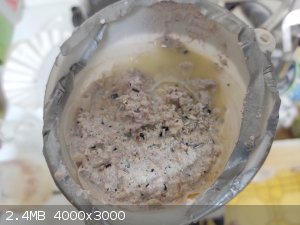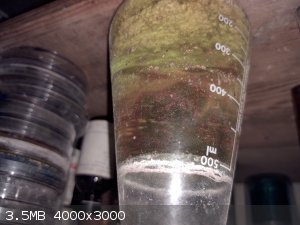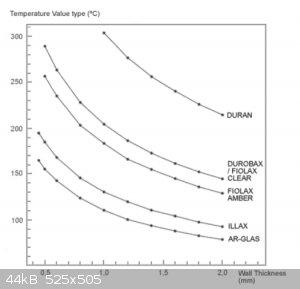| Pages:
1
2 |
Refinery
Hazard to Others
  
Posts: 371
Registered: 17-2-2014
Member Is Offline
Mood: Still
|
|
Vacuum glass implosion?
I was wondering if anyone has ever had a glass implosion during vacuum process? People speak about this often and I've been always vary of such event,
considering the outcome would be absolutely catastrophic if flammable, possibly even toxic and boiling hot liquid is blasted into aerosol cloud and
splashing everywhere and causing instant, massive fire hazard.
Apparently, vacuum strength is linear, although boiling point is reduced exponentially when pressure drops so glassware takes most of the stress at
range where nothing actually happens, and those last few millibars matter a little in that aspect.
So, how high of a risk an implosion is, how to prevent it, and how to minimize catastrophic outcome IF such a thing occurs?
|
|
|
beerwiz
Hazard to Others
  
Posts: 128
Registered: 6-2-2014
Member Is Offline
Mood: No Mood
|
|
It happened to me in the early days during my first vacuum distillation. I taped the flat bottom flask as a precaution, then when I pulled the vacuum,
it imploded. Apparently, you should not pull a vacuum on flat bottom flasks. The tape kept the implosion at bay and no shrapnel was generated.
|
|
|
Belowzero
Hazard to Others
  
Posts: 173
Registered: 6-5-2020
Location: Member Is Offline
Member Is Offline
|
|
I've witnessed such an event.
A fellow lab student left the vacuum open on a filtration erlemeyer and went for a break, it was a full sized lab and obviously used powerful pumps.
A loud crack/explosion was the result, sending glass all over the place. Luckily noone was close to the workbench , could have been messy.
[Edited on 4-6-2020 by Belowzero]
|
|
|
Heavy Walter
Hazard to Others
  
Posts: 127
Registered: 17-12-2015
Location: Argentina
Member Is Offline
Mood: No Mood
|
|
Years ago, I evacuated a large dessicant, not knowing that the cover has to match exactly to the lid (grounded surfaces), I used a cover from other
one.
I left the evacuated dessicant in a table, left the room and then the dessicant exploded filling the room with shattered glass.
Then I learned about stresses in glass... and recognized a lucky day!
[Edited on 4-6-2020 by Heavy Walter]
|
|
|
Mateo_swe
National Hazard
   
Posts: 541
Registered: 24-8-2019
Location: Within EU
Member Is Offline
|
|
I read that one should not use flat bottomed round flasks when using vacuum but never heard someone have any problems with this.
I had guessed that was something that was a problem in the past and nowadays the flat bottomed round flasks were made sturdy enough to handle lab
vacuum.
But that is not correct i have understood now.
For using vacuum one should use real round bottom flasks, not the flat bottomed versions.
That makes me think about glassware of bad quality.
I have had several funnels and other glassware break while washing them and not from hitting them against something, just temperature and minor
physical stress while wiping them dry.
I wonder how this Chinese ebay glassware i always buy will handle stronger vacuum, anyone have had any vacuum accidents using this cheap glassware?
|
|
|
Tsjerk
International Hazard
    
Posts: 3032
Registered: 20-4-2005
Location: Netherlands
Member Is Offline
Mood: Mood
|
|
The only flat bottoms you can pull a vacuum on are the thick walled Buchner funnels designed for vacuum filtration.
|
|
|
Mateo_swe
National Hazard
   
Posts: 541
Registered: 24-8-2019
Location: Within EU
Member Is Offline
|
|
Yeah, those are made for vacuum.
Its quite amazing how much strength the round shape adds to a structure.
I wonder if that was not the case, would birds lay cube shaped eggs?
|
|
|
morganbw
National Hazard
   
Posts: 561
Registered: 23-11-2014
Member Is Offline
Mood: No Mood
|
|
Quote: Originally posted by Tsjerk  | | The only flat bottoms you can pull a vacuum on are the thick walled Buchner funnels designed for vacuum filtration. |
That is what I use. The vacuum I pull is not full though. Never any problems with vacuum filtration.
|
|
|
Eddie Current
Hazard to Self
 
Posts: 78
Registered: 25-7-2018
Member Is Offline
|
|
Yes, during a vacuum filtration, not a distillation..
I incorrectly filtered a heavy precipitate with a 500ml B24 Erlenmeyer flask and a B24 fritted vacuum funnel w/nipple, instead of a 500ml B24 vacuum
flask.
I identified the problem a couple of minutes after I had applied vacuum and attempted to shut it down, but ended up showered in reaction contents and
shattered glass and had to immediately get under the shower.
Fortunately, I was not seriously injured.
It was an easy mistake to make, and the moral of the story is that you should label specialized flasks that look very similar to others.
[Edited on 14-7-2020 by Eddie Current]
|
|
|
draculic acid69
International Hazard
    
Posts: 1371
Registered: 2-8-2018
Member Is Offline
|
|
Quote: Originally posted by Mateo_swe  | Yeah, those are made for vacuum.
Its quite amazing how much strength the round shape adds to a structure.
I wonder if that was not the case, would birds lay cube shaped eggs? |
Wombats do cube shaped poo.
|
|
|
violet sin
International Hazard
    
Posts: 1480
Registered: 2-9-2012
Location: Daydreaming of uraninite...
Member Is Offline
Mood: Good
|
|
I got sprayed with some paste recently. Home made buchner on standard 1000ml erlenmeyer. The return line to vac comes out the stopper, not off the
flask. Had as purchased catch bottle between the vac, but it was loosing too much vacuum at one joint to relieve the pasty mush of it's liquid.
Anyhow after I took the catch bottle off, it was noticed how much more pull was realized and I was using bursts of vac and let off, vent for sure,
repeat... Then got lost in thought... POP!! Titania/alumina with some PdCl2 left it whizzed past me and on the wall, ceiling, floor.
The büchner itself is a (ok laugh if you will) cat wet food dish I perforated taped to the top of a 1$ store funnel. The tape separated and dish
lurched down in then stopped abruptly.
 
1) Imploded make shift büchner
2) Prior to filtration, plenty of Pd dropping out, presumably from HCl loss over time (thumbnail looks upside down, picture is not)
The old surface mount monolithic capacitors and resistors do have stuff to relieve them of. This is like the fourth or fifth pull after leaving to
digest repeatedly.
I was really glad to see only the funnel break as my hands were right there when it went, I was aware of the issue, I knew it needed to be
feathered... And I spaced out for a sec talking to the misses as she went by. It was avoidable and a decent learning experience, only b/c it was
without injury. Still had to clean splatter off the ceiling, walls, cupboard, sink and such. Paying attention is important
|
|
|
Refinery
Hazard to Others
  
Posts: 371
Registered: 17-2-2014
Member Is Offline
Mood: Still
|
|
I was scared when I saw Nurdrage used erlenmeyers for vacuum distillation.
Aren't erlenmeyers unsuitable for any sort of vacuum due to their flat bottom?
|
|
|
outer_limits
Hazard to Others
  
Posts: 139
Registered: 3-3-2020
Member Is Offline
Mood: hybridized
|
|
They aren't designed for vacuum. The only erlenmeyers that could be used are filtration flasks which were mentioned.
They are convenient to use on hotplate stirrer but somebody following directly his procedures could be damaged after implosion.
|
|
|
Refinery
Hazard to Others
  
Posts: 371
Registered: 17-2-2014
Member Is Offline
Mood: Still
|
|
I think implosion is not just a nuisance merely a joke, but absolute catastrophe that can put life in immediate danger. I don't really like the idea
of any chemical spilling on me, and many chemicals are really nasty to be very conservative, starting from boiling acids to some very toxic stuff.
Implosion type event will just burst the contents all around.
|
|
|
morganbw
National Hazard
   
Posts: 561
Registered: 23-11-2014
Member Is Offline
Mood: No Mood
|
|
Implosion is real, most never see it as they use proper vessels.
Physics is real, ignore at your own risk.
|
|
|
Eddie Current
Hazard to Self
 
Posts: 78
Registered: 25-7-2018
Member Is Offline
|
|
Quote: Originally posted by Refinery  | I was scared when I saw Nurdrage used erlenmeyers for vacuum distillation.
Aren't erlenmeyers unsuitable for any sort of vacuum due to their flat bottom? |
It has more to do with glass thickness, and never place a vacuum flask under heat, they are not designed for this.
Erlenmeyers/flat bottom flasks are for reactions (cooling & heating), and non vacuum distillation.
Round bottom flasks are for reactions (cooling & heating), and vacuum distillation.
Vacuum flasks are for vacuum filtering only.
[Edited on 15-7-2020 by Eddie Current]
|
|
|
SWIM
National Hazard
   
Posts: 970
Registered: 3-9-2017
Member Is Offline
|
|
Filter flasks are fine under heating.
In fact, its hard to imagine how anyone could possibly think otherwise.
It just makes no sense whatsoever.
Do you have an actual source for this or did you just make it up?
|
|
|
S.C. Wack
bibliomaster
    
Posts: 2419
Registered: 7-5-2004
Location: Cornworld, Central USA
Member Is Offline
Mood: Enhanced
|
|
"Thick walled glassware, such as jars, bottles, cylinders and filter flasks, should never be heated on hot plates."
Care and Safe Handling of Laboratory Glassware
|
|
|
Eddie Current
Hazard to Self
 
Posts: 78
Registered: 25-7-2018
Member Is Offline
|
|
Quote: Originally posted by S.C. Wack  | "Thick walled glassware, such as jars, bottles, cylinders and filter flasks, should never be heated on hot plates."
Care and Safe Handling of Laboratory Glassware |
This is further complicated when pressure is added to the equation.
Can you heat them somewhat? Sure.
Is it a good general practice? No.

http://www.vidrasa.com/eng/products/duran/duran_pf.html
[Edited on 16-7-2020 by Eddie Current]
|
|
|
Mateo_swe
National Hazard
   
Posts: 541
Registered: 24-8-2019
Location: Within EU
Member Is Offline
|
|
I often use flat bottomed round flasks for vacuum filtration with fritted funnels that has vacuum nipples.
But i use quite weak, cheap little pumps for these filtrations that doesnt make very strong vacuum.
It has crossed my mind that its not optimal and one can have an accident, but the flat bottomed flasks seem quite robust and the pump quite weak.
I have a ceramic buchner with a real earlenmyer filter flask but this is a quite large setup so i often use the fritted funnels with ordinary flasks
for vacuum filtrations.
Maybe i should only use the round flasks for this in the future.
The risk for implosion is bigger with larger flasks i think.
|
|
|
SWIM
National Hazard
   
Posts: 970
Registered: 3-9-2017
Member Is Offline
|
|
Thick walled flasks used for filtering are fine for heating just like thick walled RBFs and thick walled Erlenmeyers.
All thick walled, and all fine for heating.
If you actually believe you can't heat a thick walled flasks, then why do you have such a boner over even thicker walled reaction vessels? Do you
yearn for one so you can not heat it? Got a lot of room-temperature chemistry you wanna try on a big scale?
Why do you think anybody would manufacture 24/40 joint Erlenmeyer reaction flasks if they couldn't be heated? More room temp chem?
The quote you posted also makes no reference whatsoever to the safety of heating filter flasks.
So here's a nice exercise in communications skills for you:
Can you analyze the sentence you posted and figure out what it actually says?
|
|
|
S.C. Wack
bibliomaster
    
Posts: 2419
Registered: 7-5-2004
Location: Cornworld, Central USA
Member Is Offline
Mood: Enhanced
|
|
It's well known that the thicker the glass the more thermal stress. If one has a heat source at say 150C and a container of liquid at 25C, above a
certain thickness it will crack. Annealing thick glass properly takes a long time.
|
|
|
Eddie Current
Hazard to Self
 
Posts: 78
Registered: 25-7-2018
Member Is Offline
|
|
Quote: Originally posted by SWIM  |
Thick walled flasks used for filtering are fine for heating just like thick walled RBFs and thick walled Erlenmeyers.
All thick walled, and all fine for heating.
If you actually believe you can't heat a thick walled flasks, then why do you have such a boner over even thicker walled reaction vessels? Do you
yearn for one so you can not heat it? Got a lot of room-temperature chemistry you wanna try on a big scale?
Why do you think anybody would manufacture 24/40 joint Erlenmeyer reaction flasks if they couldn't be heated? More room temp chem?
The quote you posted also makes no reference whatsoever to the safety of heating filter flasks.
So here's a nice exercise in communications skills for you:
Can you analyze the sentence you posted and figure out what it actually says?
|
It's a thread about vacuum implosions.
Go and waste someone else's time with your repetitious mindless dick sizing.
It's boring.
|
|
|
SWIM
National Hazard
   
Posts: 970
Registered: 3-9-2017
Member Is Offline
|
|
Is there something seriously wrong with you?
You say something inaccurate and expect it to stand because its not the subject of the thread?
I'm sure having to actually be accurate must be boring for you, but maybe you'll get over that some day.
You have, however, given us all a fine insight into your personality.
A word of honest advice: You might want to avoid doing that too often.
A filter flask is suited to heating like a Lamborghini is suited to plowing a field.
It works just fine, like it was built for it.

[Edited on 17-7-2020 by SWIM]
|
|
|
outer_limits
Hazard to Others
  
Posts: 139
Registered: 3-3-2020
Member Is Offline
Mood: hybridized
|
|
Quote: Originally posted by SWIM  |
If you actually believe you can't heat a thick walled flasks, then why do you have such a boner over even thicker walled reaction vessels? Do you
yearn for one so you can not heat it? Got a lot of room-temperature chemistry you wanna try on a big scale?
|
You can do everything you want but sometimes the consequences could be bad. Erlenmayer flasks shouldn't be heated strongly and it is caused by their
shape. Their thermal expansion is not uniform so they are prone to breaks.
|
|
|
| Pages:
1
2 |